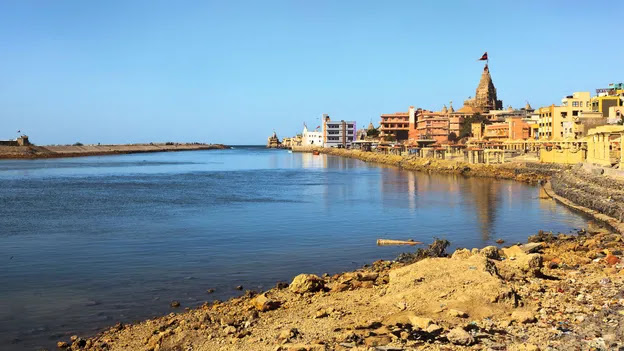The Submerged City of DWARKA
The Submerged City of DWARKA is known in Hindu culture to have been the great and beautiful city of Krishna. The Hindu writings say that when Krishna left the Earth to join the spiritual world, the age of Kali began and Dwarka and its inhabitants were submerged by the sea. The tales of the submersion can also evoke a tsunami like the one that struck India in 2004.
Once upon a time, After 17 battles with Jarasandh to protect his people, Lord Krishna moved from Mathura to a place on the coast of Saurashtra to establish his capital there. To grant him his wish, Samudra-dev, the lord of the sea, receded to give him 12 yojanas.
Vishwakarma, the divine architect, built him a new city. Planned and beautiful, this new capital flourished with wealth and was called the Dwarka or Dwaravati. The name thus referring to a place that’s a doorway towards union with Brahma, or in other words a place for spiritual liberation.
See aslo - Brahma Muhurta Time - Best Time to Wake Up in the Morning
After the demise of Krishna, Dwarka was submerged in 3031 BCE.
“...there was really a city which got submerged in Dwarka which we call it as The Submerged City of DWARKA and that the architectural evidence and antiquities such as a seal and inscriptions go to indicate that it was the city of the Mahabharata age.”
See also - Chakravyuh | Padmavyuha The Biggest Secrets
Explorations done between 1983 and 1990 have revealed submerged ruins of a great city off present day Gujarat. Built across six sectors, this submerged city’s boundary walls rest on boulders proving that the land was reclaimed from the sea. The general layout of this city matches with the descriptions from the Mahabharata.
The modern Dwarka is today one of the seven sacred towns of Hinduism, visited each year by pilgrims worshiping Krishna. The search for its submerged part began in the 1930s, and the first archaeological excavation took place in 1963. Numerous ancient artefacts were found, as well as the submerged remains of the submerged city of Dwarka during the next excavation led by an underwater archaeologist.
Between 1983 and 1990 the archaeologists discovered a fortified foundation on which the ancient city walls must have been built along the river banks. Stone blocks used for the construction, pillars and irrigation systems were found but a debate is still ongoing regarding the dating of the vestiges, either from 3,000 to 1,500 years BC or from the Middle Ages.
Numerous stone anchors have also been recovered on the site at the same depth, which suggests, along with the size of the submerged part of the ancient city, that The Submerges City of Dwarka must have had a place in the trading relations between Indian and Arabic areas during the 15th to 18th centuries and must have been an important trade port in the past. The world ‘dwarka’ means ‘door’ or ‘gate’ in Sanskrit, so this ancient port city could have been a gate for foreign sailors who arrived in India
The mystery of the Dwarka seal :
Among the objects recovered during the marine excavations from Dwaraka, was a distinctive, unique seal of a three-headed animal, with the images of a bull, a unicorn and a goat engraved on it.
This finding establishes the submerged Dwaraka’s connection with the Dwaraka of the Mahabharata. It confirms that the three-headed animal seal, as mentioned in the texts, was not a product of imagination of the author but an account of a fact. The three-headed mudra was a mark of identity for the legal residents of Dwaraka.
This differentiated the citizens of Dwaraka who had migrated along with Krishna, from the infiltrators who kept coming from the ranks of their enemy Jarasandha.
- Stages of Human Life
- Brahma Muhurta Time - Best Time to Wake Up in the Morning
- 12 Types of Legal Heir ( Children ) in Ancient India
- Chakravyuh | Padmavyuha The Biggest Secrets
- How to practice Dhyana by Ved, Science and Maths
- Significance of Feeding Crows
- 16 Adornments सोलह श्रृंगार (Solah Shringar)
- Significance of Choice of Morality - Part 1
- Significance of Choice of Morality - Part 2
- 10 Things Hindu Men Must Follow
- What Hindu Women Must Know
- Why do Hindus Wear Bindis and Tilaks on Their Forehead? Science and Significance behind Tilak and Bindi
- Who is a Hindu?
- Classification of Hindu Scriptures
- Dance in Hindu Civilization
- The Story of Adi Shankaracharya
- When A Devotee Offered Meat to Lord Shiva
- The Story of Gajendra Moksha Stotra
- Mysteries about Baba Amarnath Cave Temple
- Secrets of DEVI DURGA
- Draupadi
- Hanuman Janmotsav
- How 100 Kauravas Were Born
- Secrets Of SHRIMANT PESHWA BAJIRAO
- Philosophical and Spiritual Significance Of Ramayana
- DAY 1 of NAVARATRI 2021 :- Maa Shailaputri
- DAY 2 of NAVARATRI 2021 :- Brahmacharini Devi
- DAY 3 of NAVARATRI 2021:- Chandraghanta Devi
- DAY 4 of NAVARATRI :- Kushmanda Devi
- DAY 5 of NAVARATRI :- Skandamata Devi
- DAY 6 of NAVARATRI :- Katyayani Devi
- DAY 7 of NAVRATRI :- Kalaratri Devi
- DAY 8 of NAVRARATRI :- Mahagauri Devi
- DAY 9 of NAVARATRI :- Siddhidhatri Devi
- The Submerged City of DWARKA
- How to manifest anything you want
- Chanakya Teachings and advice | Chanakya Quotes
Follow on Insta - ancient.bharat_
Mysteries and secrets,The Submerged City of DWARKA,dwarka,dwaraka,dwarika,dwarka temple,dwarkadhish temple,dwarka delhi,dwarka gujarat,dwarka underwater,dwarka expressway,dwarka eco beach resort,dwarka courier,dwarka expressway projects,dwarka expressway news,dwarkanath sanzgiri
